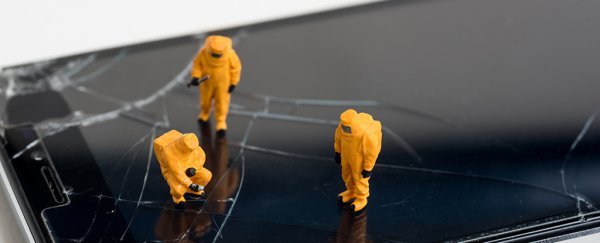Dropping your smartphone often means living with a cracked screen until your next upgrade, or footing an expensive repair bill – but researchers have been busy bringing self-healing display technology closer to a practical reality.
A team from the Korea Institute of Science and Technology (KIST) has developed a self-healing electronic material that can repair its own cracks and other physical damage, and it has one secret ingredient: linseed oil.
Linseed oil is made from flax plant seeds, and these same seeds were adapted by the researchers in a similar way in order to add them to colourless polyimide (CPI) – an alternative to glass that's already finding uses in folding smartphone screens.
That added oil ingredient is able to seep into cracks made when the CPI is fractured, and – if the scientists are able to get it working reliably at scale, could mean screens that are able to bandage their own wounds after a smash.
"We were able to develop a self-healing, colourless polyimide that can radically solve the physical properties and lifespan of damaged polymer materials," say the researchers.
The linseed oil that aids this self-healing was first loaded into microcapsules which were then mixed with a silicone material. That material was then used as a coating on top of CPI in the experiments the researchers ran.
The way that the material is designed means that breaks in the CPI also lead to breaks in the microcapsules, releasing the stored oil to repair the damage. When the oil substance hits the air, it hardens, and the material is almost as good as new.
Even better, this all works at room temperature and without the need for external pressure, unlike similar self-healing materials that have been explored before. Higher temperatures, greater humidity and ultraviolet light can speed up the healing process, the researchers report.
In ideal conditions under UV radiation the material can replace 91 percent of cracks in as little as 20 minutes, based on the new study, while remaining flexible.
While there's plenty of work still to do to get this technology out of the lab and into smartphone screens, the findings so far are encouraging.
While folding phones from the likes of Samsung and Motorola are now on the market, they remain expensive, and there are still questions about their durability. This developing technology could well make phone displays more robust, whether they're of the folding variety or not.
The benefits of this technology could go way beyond broken smartphone screens as well: CPI is a material used everywhere from artificial skin to solar panels, and any improvement in durability and resilience is going to help across the board.
"We anticipate that these multi-stimuli responsive colourless self-healing polymers may eventually be widely used in outdoor applications, such as in transparent displays and/or optically-related fields of flexible electronics," write the researchers in their published paper.
The research has been published in Composites Part B: Engineering.
